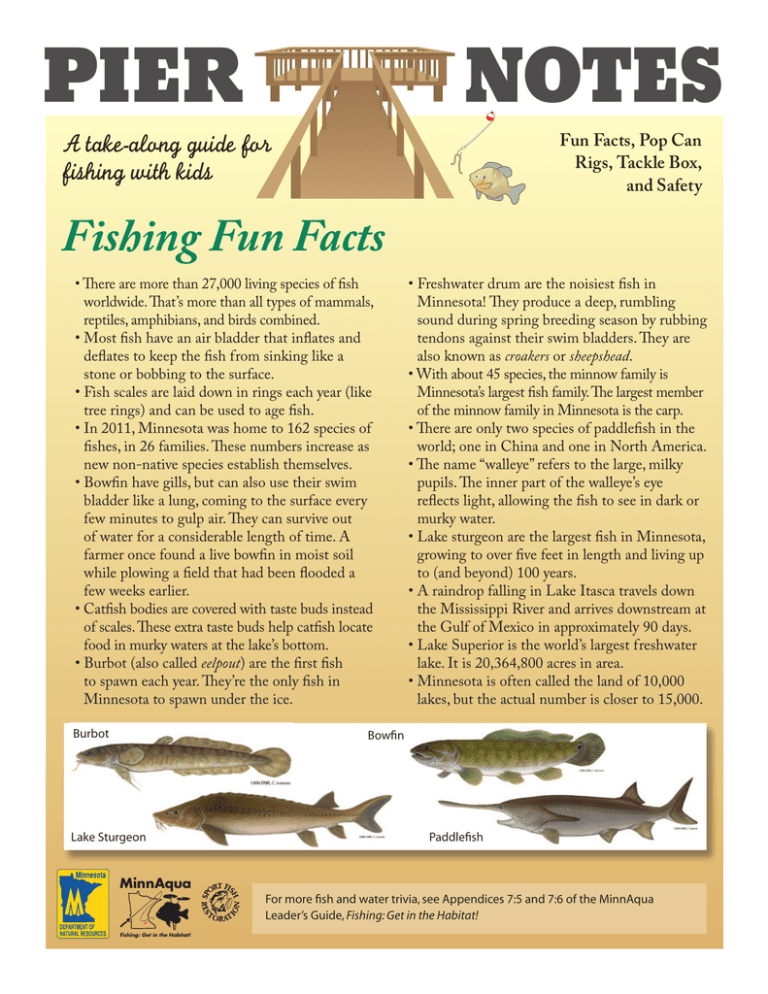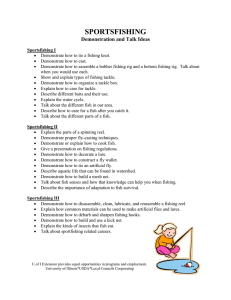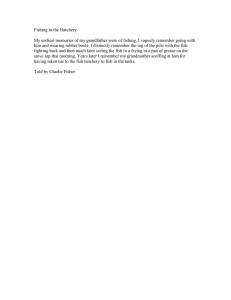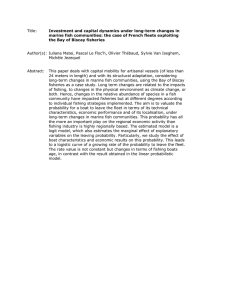Pier Notes - Minnesota Department of Natural Resources
advertisement

PierNotes A take-along guide for fishing with kids Fun Facts, Pop Can Rigs, Tackle Box, and Safety Fishing Fun Facts • There are more than 27,000 living species of fish worldwide. That’s more than all types of mammals, reptiles, amphibians, and birds combined. • Most fish have an air bladder that inflates and deflates to keep the fish from sinking like a stone or bobbing to the surface. • Fish scales are laid down in rings each year (like tree rings) and can be used to age fish. • In 2011, Minnesota was home to 162 species of fishes, in 26 families. These numbers increase as new non-native species establish themselves. • Bowfin have gills, but can also use their swim bladder like a lung, coming to the surface every few minutes to gulp air. They can survive out of water for a considerable length of time. A farmer once found a live bowfin in moist soil while plowing a field that had been flooded a few weeks earlier. • Catfish bodies are covered with taste buds instead of scales. These extra taste buds help catfish locate food in murky waters at the lake’s bottom. • Burbot (also called eelpout) are the first fish to spawn each year. They’re the only fish in Minnesota to spawn under the ice. Burbot • Freshwater drum are the noisiest fish in Minnesota! They produce a deep, rumbling sound during spring breeding season by rubbing tendons against their swim bladders. They are also known as croakers or sheepshead. • With about 45 species, the minnow family is ­Minnesota’s largest fish family. The largest mem­ber of the minnow family in Minnesota is the carp. • There are only two species of paddlefish in the world; one in China and one in North America. • The name “walleye” refers to the large, milky pupils. The inner part of the walleye’s eye reflects light, allowing the fish to see in dark or murky water. • Lake sturgeon are the largest fish in Minnesota, growing to over five feet in length and living up to (and beyond) 100 years. • A raindrop falling in Lake Itasca travels down the Mississippi River and arrives downstream at the Gulf of Mexico in approximately 90 days. • Lake Superior is the world’s largest freshwater lake. It is 20,364,800 acres in area. • Minnesota is often called the land of 10,000 lakes, but the actual number is closer to 15,000. Bowfin Lake Sturgeon Paddlefish MinnAqua For more fish and water trivia, see Appendices 7:5 and 7:6 of the MinnAqua Leader’s Guide, Fishing: Get in the Habitat! Fishing: Get in the Habitat! Make Your Own Fishing Rig You don’t need a lot of expensive equipment to go fishing. If you know how to tie a clinch knot and attach a split shot sinker and bobber, you can make your own fishing rig from an empty soda pop can! Materials: *One empty pop can (rinse it to avoid attracting bees), *Masking tape, *Fishing line (about 10 yards), *Fingernail clippers or scissors, *Hook, *Split shot sinker(s), *Bobber Building the rig: 1)Tie one end of line to tab on can, or around top of can with a knot. 2) Securely tape knot and line by wrapping tape around top of can. 3)Wrap line around middle of can (about 50 wraps) leaving about two feet of line to work with. 4)Temporarily tape line to can to prevent unraveling during next step. 5) Attach bobber, split shot sinker, and hook. 6) Wrap tackle around can and tape hook to side of can until ready to fish. To cast your line: 1)Unwind line about two feet past the bobber. 2)Hold top end of pop can in one hand and the tackle in the other (don’t cover the line wrapped around the can with your fingers). 3) Point the bottom of can to where you want the tackle to go. 4)Toss the tackle underhanded and the line should unwind off can. To reel in a fish, just wrap the line back around the can, keeping it tight until you can grab the fish. Tying an improved clinch knot: Step 1 Step 2 ©MN DNR Step 3 Step 4 ©MN DNR MinnAqua ©MN DNR For more information about making pop can casters, see Chapter 5: Lesson 3 of the MinnAqua Leader’s Guide, Fishing: Get in the Habitat! Fishing: Get in the Habitat! What’s In Your Tackle Box? A tackle box is an angler’s toolbox. To fish effectively and safely, you’ll want the right things in your tackle box. When pier-fishing for panfish, keep it simple. Here’s a basic guide to what to keep in your tackle box. Fishing regulations booklet Hooks, bobbers, and split shot sinkers Fishing line (6 lb.) Fingernail clipper Adhesive bandages Live bait or appropriate fishing lures Needle-nosed pliers ©MN DNR Other items you may choose to include: A first aid kit, knot-tying reminder card, practice casting plug, measuring tape, fish stringer, whistle, small bag for trash, lake maps, camera, hook sharpener, fish ID guide, etc. Personal gear like hat, sunscreen, sunglasses, rain gear, etc. ! Did you know? Cutting fishing line with your teeth is a bad idea! Biting fishing line to cut it can seriously chip and damage your teeth. Keep a fingernail clipper in your tackle box or your pocket and don’t use your teeth! ©MN DNR MinnAqua For more information about stocking your tackle box, see Chapter 5: Lesson 4 of the MinnAqua Leader’s Guide, Fishing: Get in the Habitat! Fishing: Get in the Habitat! Planning for Safe Fishing Safety should always be the first consideration when you take children or students fishing. It’s important to take a few moments to make sure you have the materials, procedures, and knowledge to make your fishing experience safe and enjoyable. Safety materials checklist: Cell phone, first aid kit, drinking cups and water, personal flotation devices (PFDs) as needed, sunscreen, hats with brims, insect repellent, weather-appropriate clothing, sturdy shoes (no sandals or flip-flops), ©MN DNR sunglasses, a whistle. Water safety: Avoid fishing from docks or piers without railings, set clear boundaries and rules if shore-fishing, beware of currents in moving water, have poor swimmers wear PFDs, have a throwable PFD available. ©MN DNR Weather safety: Have a radio nearby with fresh batteries, watch for changes in the weather, keep your cell phone available, know how to get to the nearest secure shelter, take shelter at the ©MN DNR first sign of lightning or severe weather, wear a hat and apply sunscreen as needed, take frequent water and shade breaks on a hot day. Hook safety: Practice proper rod handling and casting techniques, always look behind you before casting, wear sunglasses and hat to protect head and face from wayward hooks, consider using barbless hooks or flatten barbs with pliers, use only safe techniques for lines snagged on branches or rocks. ©MN DNR How to safely free a snagged line: 1) Move as close to the snagged hook as possible 2) Get everyone out of the “danger zone” (the area where the hook will fly if it becomes dislodged) 3) Tighten your drag 4) Hold the rod handle out and up at an angle away from yourself 5) Turn your head and close your eyes then pull up and back slowly and steadily 6) If the hook does not come loose easily just cut the line and re-rig. Did you know? A hook embedded in the skin is best removed by a medical professional, and should be immobilized using a paper cup and tape. In the event of a hook embedded in an eye, be sure to cover both eyes to minimize eye movement. ! ©MN DNR MinnAqua For more information about fishing safety, see Chapter 6: Lesson 1 of the MinnAqua Leader’s Guide, Fishing: Get in the Habitat! Fishing: Get in the Habitat! The Minnesota DNR is an equal opportunity employer and program provider. ©2010, State of Minnesota, Department of Natural Resources



